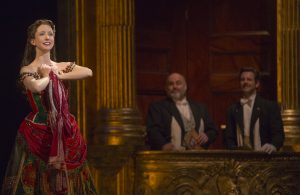DROPPING THE DROPPING CHANDELIER
Andrew Lloyd Webber’s mega-musical wants to be an opera about opera to end opera. Ironically, “Hannibal,” its first-act spoof of a 19th-century grand opera of the Meyerbeer persuasion, is no more overwrought or grandiloquent than the show that surrounds it, beloved as it is by countless legions. Like Webber’s early hit Joseph and the Amazing Technicolor Dreamcoat, the score is a pastiche, its ardent homage stretching from Frederick Loewe to Giacomo Puccini.
After five Phantoms, I still wonder at the pumped-up passion of “Music of the Night” and “Wishing You Were Somehow Here Again” (a wish the Phantom always grants). What’s missing between the songs is a (sub)text to make us truly feel the Phantom’s drive to control and Christine as more than just a fantasy fought over by this Parisian terrorist and his aristocratic rival Raoul. What we learn of the Phantom’s motivation is ludicrously lame: He’s shaking down the Paris Opera House for money while stealing their soprano. Gaston LeRoux’s potboiler creates a kind of Beauty and the Beast-meets-Svengali, a glorified stalking saga where obsession outweighs morality. It’s not for nothing that its greatest success till now was as a silent film with Lon Chaney: This melodrama is visceral and visual, not subliminal or contemplative. It’s the ultimate musical for people who hate opera.
Heading toward a third-of-a-century and still playing London (29 years), Broadway, Las Vegas and six touring ventures, the current national tour of this singing spectacle, now playing Chicago’s Cadillac Palace Theatre, marvels at and mirrors magnificently every aspect’”above, below, onstage and off’”of the Paris Opera House. But Laurence Connor’s new staging, alas, only plays up Leroux’s theatrical stereotypes: Romantic enough in its own right (and wrongs), the score needs a compensatory realism in the performances to anchor so much anguish.
Lacking the urgent exposition to make us care what happens next, Sir Andrew Lloyd Webber’s masterwork, now upgraded in its sixth visit to Chicago and boasting an orchestra of 52, offers what for many is consolation enough and a reason to return’”a surefire extravaganza. Dispensing with the alternating massive curtains of the Harold Prince staging and the Piranesi-like catwalks leading to the catacombs below, it aims for realism over lavishness: The opera house’s Beaux Arts proscenium is now within the stage, rather than over it: A revolving turret exposes the Phantom’s literal descent as sudden steps appear to guide Christine to his lair. That somewhat shrunken “man cave” lacks the Cocteau-like underwater arms carrying candelabra (the Phantom’s boat recalling Charon’s passage to the underworld) and the huge portcullis that barred entrance. The impresarios’ office, however, is larger and much more textured, but the view from the top of the opera house feels as truncated as its opposite beneath.
 The new look includes the ballet dancers’ dressing room artfully suggesting Degas’ backstage paintings, seven huge flares that intentionally blind the audience, and the Phantom’s generous use of flash pots and smoke grenades to confuse his pursuers. Missing, alas, is the grand escalier in the opera house lobby for the “Masquerade” second-act opener: The masked ball with its bon vivants from the Jockey Club now seems to take place in a mirrored ballroom adjacent to the opera’s mezzanine–where, as happens at least twice here, our Phantom escapes all too easily.
The new look includes the ballet dancers’ dressing room artfully suggesting Degas’ backstage paintings, seven huge flares that intentionally blind the audience, and the Phantom’s generous use of flash pots and smoke grenades to confuse his pursuers. Missing, alas, is the grand escalier in the opera house lobby for the “Masquerade” second-act opener: The masked ball with its bon vivants from the Jockey Club now seems to take place in a mirrored ballroom adjacent to the opera’s mezzanine–where, as happens at least twice here, our Phantom escapes all too easily.
But, of course, the major pyrotechnics are the powerhouse performances by the Phantom’s Derrick Davis, his ardent tenor as supplicating as 10,000 valentines and his exposed deformity’”a face that could pass for a gibbering skull’”more wrenching than before. Katie Travis as Christine Daae is his happily harassed protegee, her soaring soprano a promissory note the Phantom wants delivered to the world. (The fact that, even when he gets his way, this serial avenger hangs a stagehand and drops a lighting fixture on the innocent crowd is not exactly endearing.) Handsome tenor Jordan Craig ardently depicts the third corner in the triangle; Raoul’s “All I Ask of You” is quite enough to ask of him.
 Dolled up in similar 19th-century knockoff costumes as in past productions, the vast chorus acquit themselves in three burlesques of grand opera and the Phantom’s “Don Juan,” itself a screeching affair despite the persuasive lyricism of “Point of No Return.” A splenetically temperamental “prima donna assoluta,” Trista Moldovan reinvents the dysfunctional diva as imperious Italian headliner Carlotta Giudicelli.
Dolled up in similar 19th-century knockoff costumes as in past productions, the vast chorus acquit themselves in three burlesques of grand opera and the Phantom’s “Don Juan,” itself a screeching affair despite the persuasive lyricism of “Point of No Return.” A splenetically temperamental “prima donna assoluta,” Trista Moldovan reinvents the dysfunctional diva as imperious Italian headliner Carlotta Giudicelli.
Oh yes, the star of the show remains the crashing chandelier. But this time around the “new” one always hangs above the audience; it does not reassemble itself after the opening auction scene’”where it’s deliciously labelled as “Lot 666”’”then tumble almost into the audience before skirting back to the stage. It’s one more hint at the lack of grandeur in this scenic reimagining, “fixing” a production that was never broken to begin with. But for the many hard-core fans this “music of the night” can do no wrong.
photos by Matthew Murphy & Alastair Muir
The Phantom of the Opera
North American tour
reviewed at Cadillac Palace Theatre (ends in Chicago on January 8, 2017)
tour scheduled through July, 2020
for dates and cities, visit Phantom on Tour






